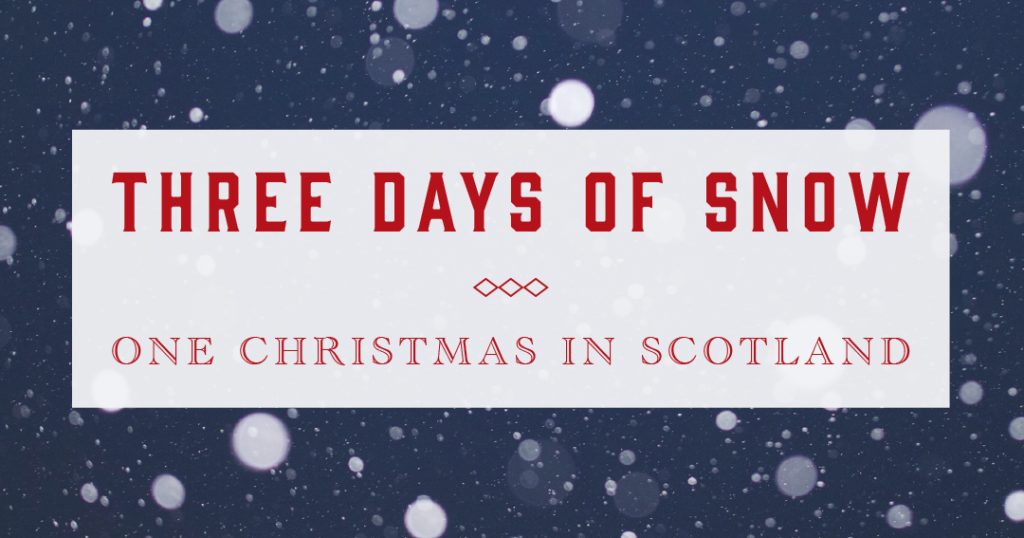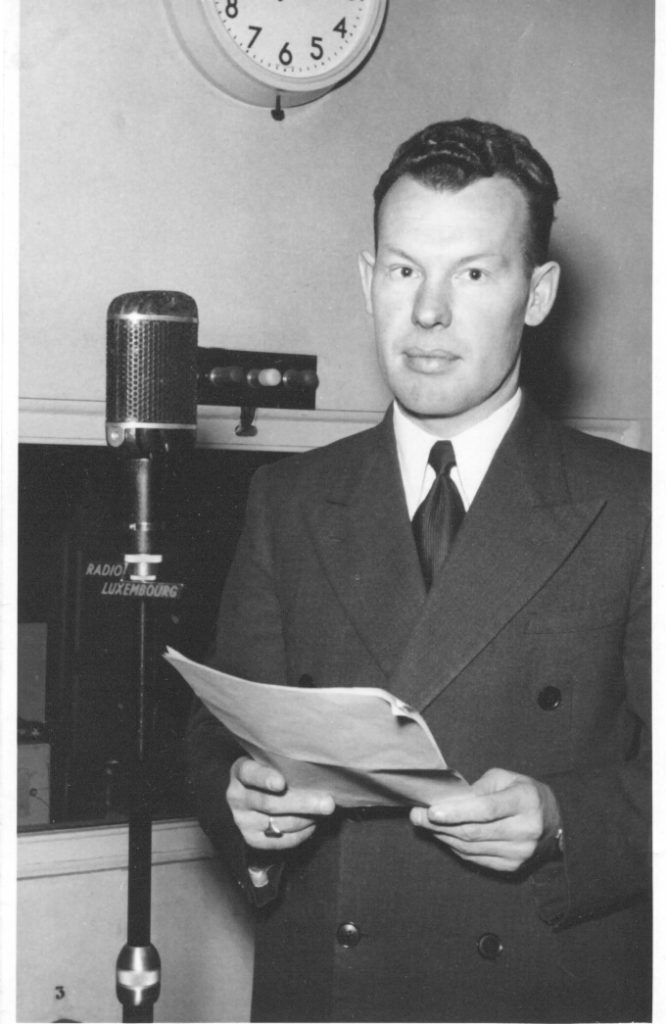Three Days of Snow: One Christmas in Scotland

by Sylvia Das
“I suppose you like this weather,” said one of the ladies at our small Scottish church, shaking the snow off her kerchief. “Yes,” I laughed. “It’s always nice to have snow on Christmas Eve.” As Canadians living on the outskirts of Glasgow, this was the first time the weather had reminded us of home.
Sometimes on our walks we’d pass through a neighbourhood with streets named after various Canadian locations: Alberta Avenue, Manitoba Crescent, Ontario Place, Saskatoon Place—a nod to relatives who had emigrated to these Canadian destinations after WWII. It was a nice reminder, but with a forecast of 15 degrees Celsius, wind and rain most days from September to December, only Vancouver Drive seemed to resemble the place it was named after.

Rev. E. George Pearce Boxing Day, 1951.
One of the first things we learned about this Glaswegian Lutheran church was that it had been planted by an energetic Canadian named Rev. E. George Pearce. Born in Edmonton, this Canadian pastor and military chaplain would go on to become the first head of the Evangelical Lutheran Church of England—a church body with congregations in England, Wales, and Scotland—at its official founding in 1954.
People here remembered Rev. Pearce as a man with a plan, organizing the showing of Jesus films in local gyms and community centres. He would follow up by visiting attendees in their homes along with people who would later serve the new congregation as elders. A building would eventually be built or bought, a pastor called, and the congregation would be nurtured. Today the ELCE has 13 congregations (and seven missions) throughout the United Kingdom, including many churches that Rev. Pearce helped to plant.
As we prepared to spend our first Christmas in Scotland, we determined there were probably more nuances than outright differences between our two cultures. After all, Canadians and Scots share a common heritage to some degree. They speak the same language (sort of) and both have historic Christian roots. While “Keeping Christ in Christmas” was a headline in Canada, we found no contention here: for Scotland (the Brave), Christmas was Christmas. Rather than holiday trees or a Santa Claus, town centres and big retailers decorated their stores with nativity scenes. Outwardly, it appeared like a “win” for Christian presence in the public square—but it wasn’t to last.
At nearly the same time, we heard a BBC Radio Scotland report that said more people now attended Catholic masses or Muslim mosques in the United Kingdom on a weekly basis than the established Protestant Church of England (or the Church of Scotland, for that matter). Traditions, it seems, may be nice reminders but they do not necessarily demonstrate a keeping of historic faith. When we asked about other Scottish traditions, members told us that even celebrations for Robbie Burns Day (which takes place January 25) are no longer much observed in the land of his birth: “They’re mostly observed by people of Scottish descent outside of Scotland.”
Even so, we continued to meet other Christians. We met them everywhere—at our church, at the community centre, at the local library where Christian books were still plentiful, and even next door.
While “Keeping Christ in Christmas” was a headline in Canada, we found no contention here: for Scotland (the Brave), Christmas was Christmas. Rather than holiday trees or a Santa Claus, town centres and big retailers decorated their stores with nativity scenes. Outwardly, it appeared like a “win” for Christian presence in the public square—but it wasn’t to last.
As we got deeper into Advent, we heard the most inspiring music coming through the walls of our manse (parsonage) from the townhouse unit next door. Two concert-level musicians were rehearsing for Christmas on their baby grand piano for three to four hours each day apiece—first one, then the other. They performed, they taught students, and, as they shared with us, they also served as musicians for the church they attended. Part of the Christmas preparations for the kids and me that year involved sitting on the landing of the stairs where the sound was at its best and reveling in it: Gloria! In Excelsis Deo!
One night over dinner we asked our neighbours what Christmas program would be considered the must-see event in the U.K. Without hesitating, they said “The Christmas Eve Carol Service from King’s College.” Not Charles Dickens’ “A Christmas Carol,” as you might imagine, not “It’s a Wonderful Life,” but “Carols from King’s” recorded at King’s College Chapel, Cambridge, and broadcast on the BBC. “People rush home on Christmas Eve to make sure they catch it.” We ended up catching it ourselves later that night with a repeat broadcast and understood its popularity. The choir of King’s College Chapel had lifted the choral arrangements to new heights, opening with:
Once in royal David’s city
stood a lowly cattle shed,
where a Mother laid her baby
in a manger for his bed;
Mary was that Mother mild,
Jesus Christ her little child.
(LSB 376:1)
On Christmas Eve with snow on the ground and the sound of tires spinning in the distance—there had been no snow in Glasgow for years—we entered the church to prepare for the 7:00 p.m. Candlelight Service. The beauty of having a common liturgy is that you can step into a partner church of Lutheran Church–Canada almost anywhere in the world and join in a familiar service. It was no different here. The hymns we sang that Christmas Eve would be many of the same ones that would be sung three-and-a-half to eight hours later in Canada (depending on the time zone). The pew Bibles and hymnals we used were the same ones we were accustomed to at our home churches in Canada. The Gospel message shared the same good news:
And in the same region there were shepherds out in the field, keeping watch over their flock by night. And an angel of the Lord appeared to them, and the glory of the Lord shone around them, and they were filled with great fear. And the angel said to them, “Fear not, for behold, I bring you good news of great joy that will be for all the people. For unto you is born this day in the city of David a Saviour, who is Christ the Lord. And this will be a sign for you: you will find a baby wrapped in swaddling cloths and lying in a manger.” And suddenly there was with the angel a multitude of the heavenly host praising God and saying, “Glory to God in the highest, and on earth peace among those with whom He is pleased!” (Luke 2:8-14).
And the solemn response from the congregation:
Silent night, holy night!
Son of God love’s pure light.
Radiant beams from Thy holy face
With the dawn of redeeming grace,
Jesus Lord, at Thy birth
Jesus Lord, at Thy birth.
(LSB 363:3)
After the service, Christmas Eve also seemed the same: people rushing home to food and a little togetherness. No coffee hour that night—or, rather, no tea and coffee hour. Some Sundays the buffet of chocolate-covered biscuits was so vast that, if you lined up each biscuit end-to-end, the line might run the entire length of a grocery store aisle—with no complaints from anyone.
The snow on the ground lasted two more days, Christmas Day and Boxing Day. Then, on December 27, the weather forecast changed to 5 degrees Celsius with wind and rain.
———————
Sylvia Das is a freelance writer living in Kitchener, Ontario. Her husband, Rev. Joe Das, served as curate (vicar) to St. Columba Lutheran Church in East Kilbride, Scotland, from 2004-2005.



